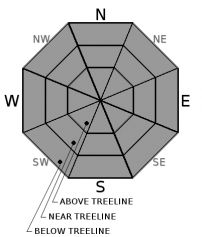| Friday | Friday Night | Saturday | |
|---|---|---|---|
| Weather: | Partly cloudy to mostly sunny | Mostly cloudy | Mostly cloudy with a slight chance of rain showers |
| Temperatures: | 55 to 60 deg. F. | 34 to 39 deg. F. | 48 to 54 deg. F. |
| Mid Slope Winds: | Southwest | Southwest | Southwest |
| Wind Speed: | 10 to 15 mph with gusts to 30 mph | 10 to 15 mph with gusts to 40 mph | 15 to 25 mph with gusts to 40 mph |
| Expected snowfall: | 0 | 0 | 0 |
| Friday | Friday Night | Saturday | |
|---|---|---|---|
| Weather: | Partly cloudy to mostly sunny | Mostly cloudy | Mostly cloudy with a slight chance of rain or snow showers. Snow level 8000 to 9000 ft. |
| Temperatures: | 48 to 56 deg. F. | 34 to 39 deg. F. | 43 to 51 deg. F. |
| Ridge Top Winds: | Southwest | Southwest | Southwest |
| Wind Speed: | 30 to 40 mph with gusts to 65 mph | 30 to 45 mph with gusts to 70 mph increasing to 80 mph after midnight | 30 to 50 mph with gusts to 100 mph decreasing to 85 mph in the afternoon |
| Expected snowfall: | 0 | 0 | 0 to 1 |























